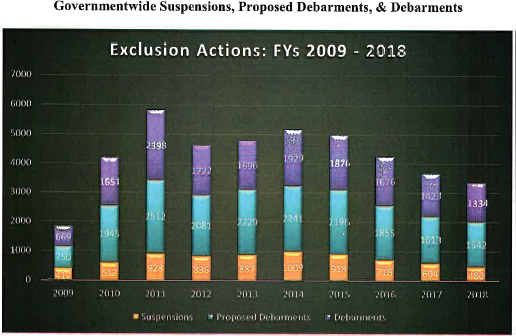The Interagency Suspension and Debarment Committee (ISDC) recently issued its annual report to Congress on federal government suspension and debarment activities for fiscal year (FY) 2018. As discussed below, this year’s ISDC report shows that, while suspension and debarment-related actions have decreased from FY 2017, the FY 2018 data still reflects “nearly double the activity reported in FY 2009,” which is the first year that the ISDC started formally tracking such data.
What is the ISDC Suspension and Debarment Report?
Created by Executive Order 12549, the ISDC is an interagency body, “consisting chiefly of representatives from Executive-branch organizations that work together to provide support for suspension and debarment programs throughout the Government.” Section 873 of Public Law 110-417 requires the ISDC to submit an annual report to Congress on, among other things, “the progress and efforts to improve the suspension and debarment system” and “a summary of each agency’s activities and accomplishments in the Government debarment system.”
What are the key takeaways from this year’s report?
As the following chart from this year’s ISDC report shows, federal agencies initiated a total of 3,356 suspension and debarment-related actions in FY 2018 (480 suspensions, 1,542 proposed debarments, and 1,334 debarments).

By comparison, in FY 2017, federal agencies initiated a total of 3,640 suspension and debarment-related actions (604 suspensions, 1,613 proposed debarments, and 1,423 debarments).
As a further point of comparison, however, the following chart from this year’s report shows that “the total number of suspensions, proposed debarments, and debarments in FY 2018 represent nearly double the activity level reported in FY 2009, when the ISDC formally commenced data tracking.”

Moreover, for FY 2018, federal agencies reported issuing 197 pre-notice letters to potential respondents, “approximately tripling the total of 70 first reported in FY 2009.” According to the report, pre-notice letters — “which include show cause letters, requests for information, and similar types of letters” — are “used to inform an individual or entity that the agency debarment program is reviewing matters for potential SDO [Suspending and Debarring Official] action, identify the assertion of misconduct, and give the recipient an opportunity to respond prior to formal SDO action.”
Finally, the report notes that, for FY 2018, 14 federal agencies reported “entering into 61 administrative agreements” — which “are used as an alternative to suspension and debarment and typically mandate the implementation of several provisions to improve the ethical culture and corporate governance processes of a respondent, often with the use of independent third-party monitors.” By comparison, in FY 2009, only 35 administrative agreements were utilized by five federal agencies to “resolve suspension or debarment concerns.”